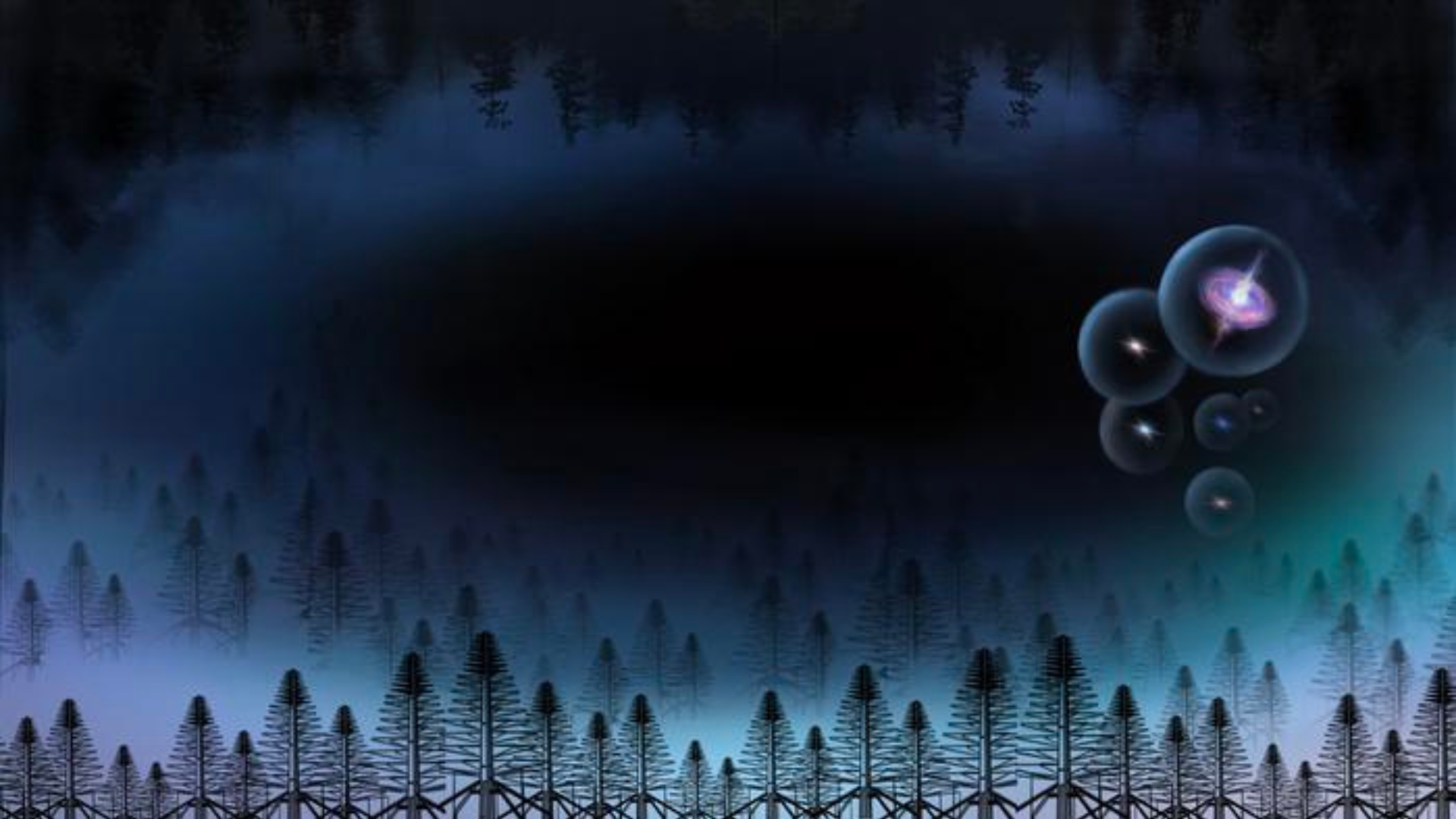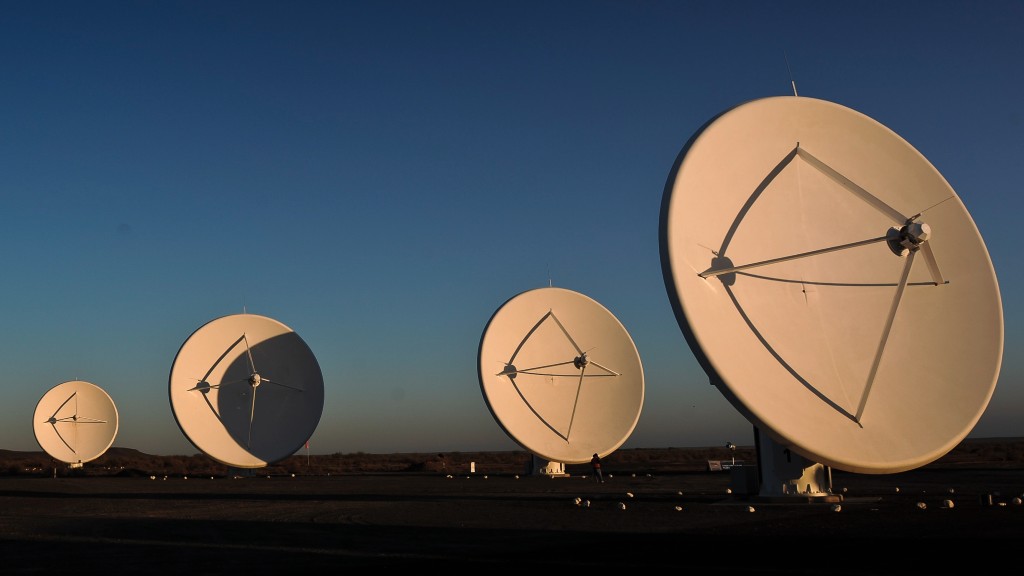World's biggest radio telescope could tease out secrets of dark matter, universe's 1st galaxies
Studying the hydrogen fingerprint from just after the Big Bang could allow researchers to kill 'two birds with one stone!'

A feature of light absorption by hydrogen surrounding early galaxies could be used as a novel new probe into the mysteries of dark matter and how it influenced the evolution of the universe during the cosmic dark ages.
Scientists have long theorized that dark matter, a mysterious substance that makes up around 85% of the matter in the universe, played a huge role in the formation of early galaxies. But because dark matter doesn't interact with light (unlike the "normal" matter that makes up stars, planets and us), its nature remains unknown. That means the precise role it played as galaxies began to form remains a gap in cosmological models.
To investigate this puzzle, scientists from Northeastern University in China and the National Astronomical Observatories of the Chinese Academy of Sciences (NAOC) have suggested a novel probe to shed light on both the nature of dark matter and the early formation of galaxies.
Related: We have never seen dark matter and dark energy. Why do we think they exist?
One possible way of investigating the particles that comprise dark matter and their mass has been by studying small-scale structures in the universe. The problem comes when attempting to do this for a period called "cosmic dawn," around 380 million years after the Big Bang, a time when the earliest stars were just being born. There were thus few viable light sources to illuminate this ancient epoch for astronomers.
But there were atoms during this era, in the form of a gas of the lightest chemical element, hydrogen. Like all elements, hydrogen absorbs light at characteristic wavelengths, leaving its fingerprint on light passing through it.
Searching for dark matter in a cosmic forest
Atomic hydrogen gas in and around the small-scale structures that existed during the cosmic dawn, which ended around one billion years after the Big Bang, creates characteristic absorption lines at 21 centimeters, in the radio range of the electromagnetic spectrum. These are collectively called the 21-cm forest, which has been proposed as a potential probe of gas temperature and dark matter during cosmic dawn for over 20 years.
Get the Space.com Newsletter
Breaking space news, the latest updates on rocket launches, skywatching events and more!
This has remained just a theoretical concept, however, due to the fact that light from this era has been traveling for around 13.4 billion years to reach us. Along the way, it has lost energy and had its wavelength stretched and its frequency lowered, moving it down the electromagnetic spectrum toward the red region and beyond to infrared.
The more distant the source of light, the more extreme this "redshift" process is. With starlight absent, using the 21-cm forest as a dark matter probe requires radio-loud sources like quasars to be seen at cosmic dawn and thus at high redshift. But signals from such radio sources in this epoch are faint, and these high-redshift background sources are difficult to identify.
This situation may be about to change, however. Not only have a number of high-redshift radio-loud quasars been discovered recently, but the world’s largest radio telescope, the Square Kilometre Array (SKA), began construction in Australia and South Africa in December 2022 and will soon open its sensitive radio eye on the universe. This suggests that detecting and using the 21-cm forest may soon be feasible.
Related: SKA Observatory: A guide to the soon-to-be largest radio telescopes in the world

The team behind the new study thinks that measuring the distribution of energy of the 21-cm forest, or its "power spectrum," will make it a plausible probe to simultaneously measure dark matter properties and the thermal history of the universe.
This could help researchers distinguish between a cold dark matter model of the universe — one with massive dark matter particles moving slowly in comparison to the speed of light — and a hot dark matter model, with lighter and more fast-moving dark matter particles.
"By measuring the one-dimensional power spectrum of the 21-cm forest, we can not only make the probe actually feasible by increasing the sensitivity, but also provide a way to distinguish the effects of warm dark matter models and early heating process," said National Astronomical Observatories researcher Yidong Xu, corresponding author of the new study. "We will be able to kill two birds with one stone!"
As long as cosmic heating wasn't too extreme during cosmic dawn, the low-frequency capabilities of phase 1 of SKA’s operations should mean scientists can constrain the mass of dark matter particles and gas temperature. If cosmic heating was too great, then the second phase of SKA will see the instrument enlarged, leading to the use of multiple background radio sources delivering the same constraints.
As the potential use of the 21-cm forest as a dark matter probe is tied to observations of high-redshift background radio sources, the next step in this research is identifying more radio-bright sources during the cosmic dawn, including more radio-loud quasars and the afterglows of gamma-ray bursts.
These sources can then be followed up once SKA once it begins observing the universe in 2027, thus allowing astronomers to shed more light on the mysteries of both dark matter and the first galaxies.
The team’s research was presented in the July 6 edition of the journal Nature Astronomy.
Join our Space Forums to keep talking space on the latest missions, night sky and more! And if you have a news tip, correction or comment, let us know at: community@space.com.

Robert Lea is a science journalist in the U.K. whose articles have been published in Physics World, New Scientist, Astronomy Magazine, All About Space, Newsweek and ZME Science. He also writes about science communication for Elsevier and the European Journal of Physics. Rob holds a bachelor of science degree in physics and astronomy from the U.K.’s Open University. Follow him on Twitter @sciencef1rst.
-
bwana4swahili Dark Matter is a figment of researchers' imaginations. There are far simpler, and probably correct, explanations for the Universe's apparent lack of matter, i.e.: a variable gravity 'constant' comes to mind.Reply -
Classical Motion Decaying gravity would answer much, especially if it decreased very fast long ago. And continues to decrease at a very slow rate. Forever. I would highly suspect this dynamic to be so.Reply
And this does not explain rotation within a galaxy. But the trajectory and structure of the orbits can, I believe. The circumference of those orbits are assumed to be arcs, and the velocity, the length, the period and the momentum is calculated from such. But I believe the orbital circumference is not an arc, but is a helix. And therefore the amplitudes and directions of the calculations are very mis-leading. The velocity and momentum are constantly changing, and only a portion is giving you the right observed direction. An orbital helical trajectory has not been discerned. But can be observed with Io. And now finding a debris torus for all planets confirms this to me.
I do believe that our observations and measurements are and have been very mis-leading. We need to measure Z motion, along with X and Y motion. And that Z motion will be angular, not linear. An orbit has two perpendicular angular accelerations, not one.
A portion of the velocity and momentum is not in the direction of the arc, it's perpendicular to the arc. Giving more velocity and momentum than seened and measured.









